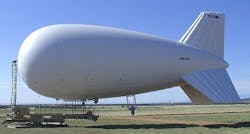Navy taps TCOM for another seven aerostats for PGSS electro-optical sensor payloads
JOINT BASE MCGUIRE-DIX-LAKEHURST, N.J., 22 March 2012. U.S. Navy officials are buying seven tethered airships for the U.S. Army's Persistent Ground Surveillance Systems (PGSS) program from aerostat producer TCOM LLP in Columbia, Md., under terms of a $13.4 million contract awarded Wednesday from the Naval Air Warfare Center Aircraft Division, Lakehurst, at Joint Base McGuire-Dix-Lakehurst, N.J.
The PGSS program mounts a broad variety of persistent-surveillance sensors on tethered helium-filled blimps that float as high as 3,000 feet off the ground for wide-area surveillance.
Earlier this month, for example, NAVAIR Lakehurst awarded FLIR Systems Inc. in Wilsonville, Ore., a $10.4 million contract option for 14 of FLIR's Star SAFIRE 380-HD digital high-definition daylight and nighttime electro-optics imaging systems for PGSS aerostats.
Wednesday's NAVAIR Lakehurst contract to TCOM, is for seven TCOM 22M aerostat systems, as well as site and tether-up spares and line replaceable units for the PGSS program.
The 22M aerostat is based on the TCOM 17M aerostat with enhanced sensor-lifting capabilities to reach altitudes as high as 3,000 feet. The system consists of the aerostat, telemetry, airborne power system, electro-optical tether, winch tether handling system, turntable mooring system, power management hardware, and control station.
The U.S. Department recognized TCOM last year for the company's performance in supplying aerostats for the PGSS program. “The United States will never go to war again without aerostats," says Alex Lovett, special assistant to the Defense Research & Engineering (DDR&E) office of the U.S. Office of the Secretary of Defense Rapid Fielding Directorate (RFD). “The information provided by these aerostats has reduced injuries and deaths caused by IEDs [improvised explosive devices] by 30 percent,” Lovett says.
For more information contact TCOM online at www.tcomlp.com or NAVAIR Lakehurst at www.navair.navy.mil.
Follow Military & Aerospace Electronics and Avionics Intelligence news updates on Twitter
